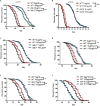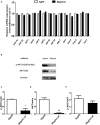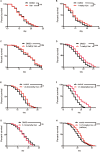Low Concentrations of Caffeine and Its Analogs Extend the Lifespan of Caenorhabditis elegans by Modulating IGF-1-Like Pathway
- PMID: 30061824
- PMCID: PMC6054938
- DOI: 10.3389/fnagi.2018.00211
Low Concentrations of Caffeine and Its Analogs Extend the Lifespan of Caenorhabditis elegans by Modulating IGF-1-Like Pathway
Abstract
Caffeine has been reported to delay aging and protect aging-associated disorders in Caenorhabditis elegans. However, the effects of low concentration of caffeine and its analogs on lifespan are currently missing. Herein, we report that at much lower concentrations (as low as 10 μg/ml), caffeine extended the lifespan of C. elegans without affecting food intake and reproduction. The effect of caffeine was dependent on IGF-1-like pathway, although the insulin receptor homolog, daf-2 allele, e1371, was dispensable. Four caffeine analogs, 1-methylxanthine, 7-methylxanthine, 1,3-dimethylxanthine, and 1,7-dimethylxanthine, also extended lifespan, whereas 3-methylxanthine and 3,7-dimethylxanthine did not exhibit lifespan-extending activity.
Keywords: C. elegans; IGF-1 pathway; caffeine; daf-2; lifespan.
Figures





References
LinkOut - more resources
Full Text Sources
Other Literature Sources
Miscellaneous

